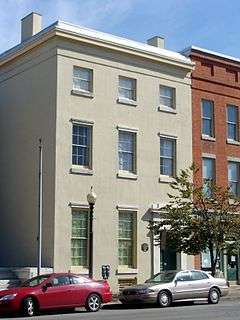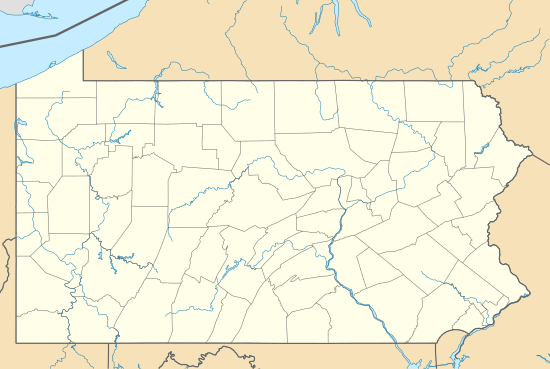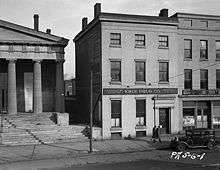Cashier's House
|
Cashier's House and Coach House | |
 | |
 | |
| Location |
413 State Street, Erie, Pennsylvania |
|---|---|
| Coordinates | 42°7′48″N 80°5′10″W / 42.13000°N 80.08611°WCoordinates: 42°7′48″N 80°5′10″W / 42.13000°N 80.08611°W |
| Built | 1839 |
| Architect | William Kelly |
| Architectural style | Egyptian Revival, Greek Revival |
| NRHP Reference # |
72001121[1] (original) 83002241 (increase) |
| Significant dates | |
| Added to NRHP | January 13, 1972 |
| Boundary increase | March 9, 1983 |
| Designated PHMC | 1980[2] |
The Cashier's House is a three-story, stuccoed brick, Greek Revival building located on State Street in Erie, Pennsylvania. It was documented by the Historic American Buildings Survey in 1934. The house was listed on the National Register of Historic Places on January 13, 1972 and its boundary was increased on March 9, 1983.[1]
History
The Cashier's House was designed by Philadelphia-architect William Kelly and was built as part of a three-structure complex, in 1839. The Coach House and Old Custom House were also part of the complex. It was built primarily as the residence for the chief executive officer of the next door Erie Branch of the Bank of the United States.[3] The bank closed in 1841, but the cashier of the bank continued to live in the house until his death in 1843.[3] In 1850, the house was sold for $4,000 ($102 thousand in present-day terms) at half of its original cost.[3] The Cashier's House was bought by Samuel Woodruff in 1872.[4] The Woodruffs occupied the Cashier's House until 1913, leading the house to sometimes be referred to as the "Woodruff Residence" or "Woodruff House."[3][5]

The state of Pennsylvania bought the Cashier's House on July 17, 1963 for $30,800 ($238 thousand today). The state restored the Cashier's House, and the next-door Old Custom House, in the late 1960s and early 1970s. On March 9, 1983, the boundary of the site—as defined by the National Register—was increased to include the Coach House. On March 12, 2013, ownership of the Cashier's House and the adjacent Old Custom House, was transferred by the Pennsylvania Historical & Museum Commission to the Erie Art Museum, which has occupied the Custom House since October, 1983.
Coach House
The Coach House, located on East 4th Street, was built at the same time of the Old Custom House and the Cashier's House. The house was sold to a marble dealer in 1882 and was sold, again, in 1904 to a blacksmith.[4] The depth of the house was expanded to nearly triple the original size by the blacksmith to house heavy machinery.[4]
Design
The Cashier's House is 30 feet 2 inches (9.19 m) wide and 125 feet 5 inches (38.23 m) deep.[5] Both the exteriors of the Cashier's and Coach Houses are Greek Revival. The interior of the Cashier's House is a rare example of Egyptian Revival architecture in Pennsylvania.[4]
See also
Notes
- 1 2 "NPS Focus". National Register of Historic Places. National Park Service. Retrieved July 1, 2010.
- ↑ "PHMC Historical Markers". Historical Marker Database. Pennsylvania Historical & Museum Commission. Retrieved December 20, 2013.
- 1 2 3 4 "Cashier's House History". Erie County Historical Society. 2008. Archived from the original on July 22, 2009. Retrieved January 4, 2009.
- 1 2 3 4 Sausman 1983, § 8.
- 1 2 Baxter 1936, p. 2.
References
- Baxter, Annie Scott (January 18, 1936). "Woodruff House". Historic American Buildings Survey. National Park Service. Retrieved January 4, 2009.
- Sausman, J. Michael; King, Jr., Victor C. (January 1, 1983). "Cashier's House and Coach House" (PDF). National Register of Historic Places Inventory—Nomination Form. National Park Service. Retrieved January 4, 2009.
External links
| Wikimedia Commons has media related to Cashier's House. |
- Cashier's House (Erie County Historical Society)

